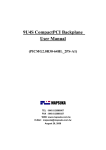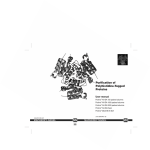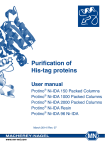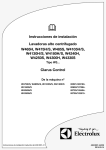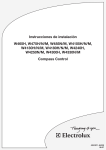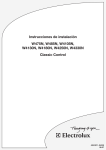Download Sharp CD180 Technical data
Transcript
MANUAL Conti-Dryer CD 25-600 Serial No. ................... ISO 08.01.02.12.GB 986041 Rev. February 1996 Rev.February 1996 Conti-Dryer CD 25-600 Page 1 1.0 CONTENTS 2.0 GENERAL INFORMATION 3 2.1 2.2 2.3 2.4 2.5 2.6 Use Limitations Construction Standards, directives, instructions etc. used Operating principles Certificates 3 3 4 5 5 6 3.0 TECHNICAL DATA 8 3.1 3.2 3.3 3.4 3.5 3.6 Technical specifications Typeplate Dimensioned sketches Capacity table Security measures Noise level 8 9 10 12 13 14 4.0 ASSEMBLY / DISASSEMBLY 15 4.1 4.2 4.3 4.4 4.5 4.6 4.7 4.8 Assembly Disassembly Connections Control Adjustment Start Operation Stop 15 17 17 18 19 19 19 21 5.0 ACCESSORIES 22 5.1 5.2 List of accessories Assembly of accessories 22 23 6.0 MAINTENANCE 25 6.1 6.2 6.3 Maintenance of filters Maintenance of magnet grid Maintenance of drying hopper 25 26 27 Rev.February 1996 Conti-Dryer CD 25-600 Page 2 7.0 TROUBLESHOOTING 28 7.1 7.2 7.3 The machine does not start/dies The machine runs, but heats insufficiently The machine dries insufficiently (temperature ok) 28 28 30 8.0 REPAIR 31 8.1 Replacement of heater 31 9.0 INDEX 10.0 SPARE PARTS NB! All electrical diagrams can be found in the pocket in the back of the manual. Rev.February 1996 2.0 GENERAL INFORMATION 2.1 Use Conti-Dryer CD 25-600 Page 3 The Conti-Dryer CD is a hot air dryer designed for drying of free-flowing plastics raw material in the form of granules. The Conti-Dryer is able to dry in batches or continuously. 2.2 Limitations The Conti-Dryer CD operates on ambient air. The final residual humidity that is obtainable will therefore always depend on the ambient temperature and relative humidity. To be able to operate continuously the Conti-Dryer CD must feature an automatic vacuum conveyor on the lid. The Conti-Dryer CD cannot be used for materials in powder or liquid form or for living organisms. The CD must be operated by a qualified operator only and according to the correct procedures. The CD must be used only for the purposes described in this manual. The machine must not be used in areas of explosive hazard. Rev.February 1996 2.3 Conti-Dryer CD 25-600 Construction The Conti-Dryer CD consists of the following main components: (1) (2) (3) (4) (5) (6) (7) (8) (9) (13) (24) (30) (31) (81) Insulated drying hopper with sight glass Lid with flange for Con-Evator vacuum conveyor Heater Filter housing Fresh air valve Control Blower Intake filter Filter bag Temperature controller Slide valve Air distributor Discharge valve Recycling filter R1620 Page 4 Rev.February 1996 2.4 Conti-Dryer CD 25-600 Page 5 Standards, directives, instructions etc. used EN - 60204 - 1 / IEC - 204 – 1 IEC – 529 AT - instruction no. 2.2.0.1 of October 1990 Directive no. 73/23/EEC (low tension directive) Directive no. 89/336/EEC changed by directive no. 92/31/EEC (EMC-directive). Directive no. 89/392/EEC changed by directive no. 91/368/EEC (machine directive). 2.5 Operation principles When the machine is turned on the blower (7) starts. The air goes pass the heater (3), via the drying hopper (1) and the filter housing (4) in a partly closed circuit. When the air in the sytem has reached the temperature preset on the temperature controller (13), the heater (3) turns off. To aid to evaporation of water vapour being released from the plastic granules, the air is exchanged by means of a fresh air valve (5). Fresh air is taken in through the intake filter (8), and the varm, moisty air leaves the system through the filter bag (9). The fresh air valve (5) is continuously adjustable to ensure an optimum ratio between recycled and fresh air. R1621 Rev.February 1996 2.6. Certificates 2.6.1 EQ-Net Certificate Conti-Dryer CD 25-600 Page 6 Rev.February 1996 2.6.2 ISO Certificate Conti-Dryer CD 25-600 Page 7 Rev.February 1996 3.0 TECHNICAL DATA 3.1 Technical specifications Conti-Dryer CD 25-600 Conti-Dryer Page 8 CD CD CD CD CD CD CD 25 50 90 180 350 500 600 Supply voltage 3 x 220/380/415/440 V 3 x 380/415/440 V 50-60 Hz 50-60 Hz Control voltage 24 V via transformator 24 Volt AC via transformer Total load, kW 1.87/ 2.87/ 6.1/ 7.5/ 12.2/ 18.0/ 19.0/ 1.95 2.93 6.3 7.8 12.5 18.6 19.6 Blower motor 50/60 Hz 0.37/ 0.37/ 1.1/ 1.5/ 2.2/ 4.0/ 4.0/ 0.43 0.43 1.3 1.8 2.5 4.6 4.6 Heater, kW 1.5 2.5 5 6 10 14 15 Average power consumption kW at 90° 0.9 1.4 2.5 4.6 8.1 12 12 Airflow m3/h 50-60 Hz at a counter pressure of 0.1 bar 25 50 90 170 300 440 440 Raw material hopper capacity, litre 25 50 90 180 350 500 600 Noise level, dB(A) 60 60 65 70 75 75 75 Power cable, m 3 3 3 5 5 5 5 Net weight, kg 43 52 85 91 175 225 240 Maximum drying temperature for standard units: 140° C. Rev.February 1996 3.2 Conti-Dryer CD 25-600 Page 9 Typeplate The typeplate is located on the side of the control containing all electrical data for connections. The serial number consists of a code (A)(B), a type number (C) and a serial number (D). 3.2.1 Code (A) and (B): The first and last digit (A) in the code indicate the year in which the machine was produced. E.g. 9ST5 = 1995. The two middle letters (B) in the code indicate whether the machine is a standard model or not. ST = Standard apparatus SP = Special construction meeting the customer’s requirements HT = HT/LT model EX = Special mark for remote controls ES = Special mark for substitute controls 3.2.2 Type (C) The type number consists of two digits that indicate the machine type: CD 25: CD 50: CD 90: CD 180: CD 350: CD 500: CD 600: 3.2.3 91 92 93 94 95 96 97 Serial number (D) The serial number consists of five digits that refer to the exact production number of the machine. The serial number consists of a code (A)(B), a type number (C) and a serial number (D). 3.2.4 Serial number (D) The serial number consists of five digits that refer to the exact production number of the machine. R1645 Rev.February 1996 3.3 Dimensioned sketches All measurements in mm. R1626 Conti-Dryer CD 25-600 Page 10 Rev.February 1996 A B C D E F G H I K L M N O P R S T Conti-Dryer CD 25-600 CD 25 750 570 490 Ø395 80 176 Ø50 120 58 13 Ø9 120 150 125 160 M8 250 CD 50 930 340 640 490 Ø360 80 176 Ø50 120 58 13 Ø9 120 150 125 160 M8 250 CD 90 1060 340 810 580 Ø500 122 216 Ø70 172 84 13 Ø13 120 150 125 160 M8 415 CD 180 1490 340 890 580 Ø545 122 216 Ø70 172 84 13 Ø13 120 150 125 160 M8 415 Page 11 CD 350 1600 340 1235 810 Ø790 158 278 Ø102 236 118 17 Ø17 120 150 125 160 M8 770 CD 500 1980 340 1235 810 Ø790 158 278 Ø102 236 118 17 Ø17 120 150 125 160 M8 770 CD 600 340 1235 810 Ø790 158 278 Ø102 236 118 17 Ø17 120 150 125 160 M8 770 Rev.February 1996 43 36 36 86 72 72 168 140 140 240 288 200 240 200 240 7.5 15 27 54 105 150 180 80 7 13.5 24 48 93 133 160 2.25 120 7 13.5 24 48 93 133 160 2.25 65-70 7 13.5 24 48 93 133 160 2.25 2.25 2.75 2.75 80 120 75 120 7 13.5 24 6 12 21.5 5.5 11 19.5 5.5 11 19.5 48 43 39 39 93 84 76 76 133 160 120 144 109 131 109 131 3.0 3.0 3.25 75 100 80 1.0 5 5 4.5 10 10 9 18 18 16.5 36 36 33 70 70 65 100 120 100 120 92 111 3.25 3.25 75-85 90 1.0 4.5 4.5 9 9 16.5 16.5 33 33 65 65 92 92 111 111 3.5 80 0.1 4 8.5 15.5 31 60 86 103 3.75 75-85 1.0 4 8 14.5 29 56 80 96 4.5 70-75 2.0 3.5 6.5 12 24 47 67 80 4.5 5.5 70-75 65-70 2.0 3.5 3 6.5 5.5 12 10 24 20 47 38 67 55 80 65 2.0 80 2.25 0.4 0.5 1.0 CD 600 24 20 20 65-90 90 80 CD 90 12 10 10 1.25 1.5 1.5 CD 50 CD 550 CD 180 Initial moisture content CL 25 CD 350 Polyethylene Polypropropylene Polystyrene Polystyrene High impact ABS Acrylonitrile Butadiene Styrene PPO Polyphenylene Oxide PVC Poly Vinylchloride SAN Styrene Acrylonitrile PI Polymide CA Cellulose Acetate PSU Polysulfene CAB CelluloseAcetate Butrane POM Polyacetal AN Barex PA Polyamide 6, 6/6 6.10 PUR Polyurethane PMMA Polymethyl Methacrylate PE Polyethylene, Black CP Cellulose Propionate PA Polyamide 6/6, 6/6 6.10 Inomere (Surlyn A) Recommended drying temp. Raw Material PE PP PS SB Page 12 Capacity table Drying time in hours 3.4 Conti-Dryer CD 25-600 The values stated in the capacity table are directive only, as shape and bulk density of the granule may influence the air speed and by that the drying ability. The tests are performed using granule with a bulk density of 0.6 and a granular size of 2-3 mm. Rev.February 1996 Conti-Dryer CD 25-600 Page 13 Drying temperatures and times are directive only, as these can vary from one producer to another. Therefore it is advisable always to check with the supplier of the relevant raw material. The capacities stated are obtained at an ambient temperature of 20° C and a relative humidity of 65% under which conditions a final moisture content of 0.04% is obtainable. A higher relative humidity could be the reason as to why the stated value cannot be obtained in all cases. Certain materials will require a lower residual humidity than the one stated, especially in matters of extrusion, and in such cases it will be necessary to use a dry air dryer type DDL, DDM or DCD. 3.5 Security measures 3.5.1 Con-Evator support All CD units, except for the smallest type, are equipped with a bracket supporting the Con-Evator vacuum conveyor when the lid is open. 3.5.2 Overtemperature protection The electronic temperature controller is equipped with an electronic overtemperature protection which automatically cut off the control current of the heater, if the temperature rise 12° C above adjusted value. In case of overtemperature condition, a red diode on the control panel lights up. The overtemperature protection is reset by switching the main switch of the machine on and off. 3.5.3 Fire protection (see fig. 8.1) All Conti-Dryer units are equipped with a fire protection (83) in the form of a thermistor (bi-metal) of 210° C. At a temperature above 210° C the circuit-breaker overload of the heater in the control is released thus cutting off main power to the heater. When the thermistor is sufficiently cooled and still in working condition, the protection is reset on the release button of the circuit breaker overload by switching the main switch of the machine off and then on. Rev.February 1996 3.5.4. Conti-Dryer CD 25-600 Page 14 Heater (see fig. 2.3) At operation at high temperatures the filter housing (4) and the heater (3) are able to reach extremely high temperatures. Signs warning against high-temperature condition are placed accordingly. 3.6 Noise level The Conti-Dryer has the following noise level according to DS/ISO-3746: Type DB(A) CD 25 60 CD 50 CD 90 60 65 CD 180 CD 350 70 75 CD 500 CD 600 75 75 Rev.February 1996 4.0 ASSEMBLY / DISASSEMBLY 4.1 Assembly Conti-Dryer CD 25-600 Page 15 The Conti-Dryer is designed for assembly directly on the processing machines replacing the machine hopper. If the Conti-Dryer flange does not match the hopper flange on the processing machine, it is necessary to make an intermediate flange. 4.1.1 Assembly flange The Conti-Dryer is supplied fully equipped. The machine is lifted in the transversed lifting fixture (10) on the frame, as shown in the sketch. R1628 WARNING: Lifting, as illustrated, must be done only with the hopper being depleted. Assembly dimensions: see dimensioned sketch section 3.3 Rev.February 1996 4.1.2 Conti-Dryer CD 25-600 Page 16 Assembly of Con-Evator The lid (2) on the machine features a cutting and a flange for assembly of a Con-Evator vacuum conveyor (11) type PGT. 1. Disassemble the cover plate (12) on CD lid. 2. Fix the vacuum conveyor (11) bolt holes matching on the lid, using 4 bolts M8. R1630 The below table indicates which types of Labotek vacuum conveyors that can be fitted on CD. CD 25 CD 50 CD 90 CD 180 CD 350 CD 500 CD 600 * MF 98* X X X PGT 4 X X X X X X X PGT 61 PGT 9 X X X X X X (X) (X) X X X1 An intermediate flange (225027) is used to fit MF 98. For reasons of weight the PGT 9 should be fitted only on CD 90 and CD 180 in their divided execution. For reasons of weight the PGT 9 should be fitted only on CD 90 and CD 180 in their divided execution. Rev.February 1996 4.2 Conti-Dryer CD 25-600 Page 17 Disassembly If it is required to disassemble the Conti-Dryer, all material must be discharged first. Power must be disconnected, and Con-Evator, if attached, disassembled. The Conti-Dryer can now be handled in the lifting fixture (10). See fig. 4.1.1 4.3 Connections 1. Check that the voltage available correspond to the voltage requirement indicated on the typeplate. The typeplate is located on side of the control (see point 3.1). 2. Connect the machine according to diagram. To be found in the back of the manual. 3. Turn on the machine using the main switch and check that the blower runs arrow directed. If not, switch two phases. 4. If a vacuum conveyor is attached, it can be power supplied from the CD. Terminals have been set out for this purpose (terminal 7.8.9 and PE). Check revolving direction at start-up of the vacuum conveyor. A label is attached on the ventilation cover where the long arrow indicates conveying and the short one filter cleaning. (See also manual for Con-Evator). 5. A potential free contact is available for connection of an external alarm. See diagram in the pocket in the back of the manual. 6. The control which is usually fixed on the unit can be placed remotely up to 10 m from the unit. 7. By remote placing the control must be turned vertically placed, like on the unit. Rev.February 1996 4.4 Control 4.4.1 Control buttons Conti-Dryer CD 25-600 Page 18 (13) Temperature controller (14) Fuse (15) Diode - power on (16) Diode - overtemperature (17) Diode - motor overloaded (18) Main switch On CD 25-180 units the whole control box can be tilted to an angle of 90 degrees thus providing easy access to all front components. On CD 350-600 units the control front plate is integrated in the cabinet. Access to components via side door in cabinet. 4.4.2 R1632 Temperature controller (13) Temperature adjusting button (19) Button for adjusting temperature. Temperature scale values displayed in both °C and °F. °C: Large, white text °F: Small, green text Adjusting the drying temperature in the area 80-130° C. Hysteresis adjusting button (20) Button for adjusting hysteresis (temperature fluctuation area). The button is placed on side of the temperature controller. The button for hysteresis adjustment is factory preset to approx. mid area. Further adjustments are usually not required. Diode voltage on (21) «Power on» indicates that the temperature controller is connected. Diode, heater on (22) R1633 Rev.February 1996 Conti-Dryer CD 25-600 Page 19 Diode, overtemperature (23) Diode giving signal if current temperature is 12° C (35°F) above/below set temperature. 4.5 Adjustment 1. Adjust required drying temperature on the temperature controller (13) 2. Adjust air intake on top of the filter by turning the fresh air valve (5). Maximum = full fresh air intake Minimum = lowest air intake and major recirculation share As a start the fresh air valve is adjusted in the middle of the interval. Adjust until required drying result is achieved. 4.6 4.7 R1634 Start 1. Close slide valve (24) in bottom of drying hopper. 2. Charge hopper either manually or by means of an attached Con-Evator. 3. Required drying temperature is adjusted on temperature controller (13). 4. Use main switch (18) to connect power. 5. Wait recommended drying time (see capacity table). 6. The slide valve (24) in bottom of drying hopper can now be opened, and production set going. Operation If the CD is used for batch drying, the hopper must be recharged whenever empty by turning off the drying apparatus and follow the above described start procedure. If the CD is used in continuous operation with Con-Evator attached, the drying hopper is charged automatically pari passu with consumption which is controlled by the Con-Evator bottom flap. It is necessary only to make sure that material is continuosly available to the Con-Evator. An alarm for missing material can be fitted. (see Con-Evator manual). Rev.February 1996 R1920-gb Conti-Dryer CD 25-600 Page 20 Rev.February 1996 4.7.1 Conti-Dryer CD 25-600 Page 21 Change of material The stop/start procedure applies to change of material also. At change of material it is recommended to clean out dust and regrind from the hopper. Remaining granulate can be removed by opening the slide valve. Dust can be removed by opening the lid or by disassemble the sight glass and clean out using compressed air - the discharge valve (31) must be kept open during this procedure. 4.8 Stop 1. If attached stop Con-Evator on main switch placed on its control. 2. Discharge the CD drying hopper either by running it dry or by discharging it through the discharge valve (31) in the cone of the drying hopper. It is recommended to leave the CD blower on during discharging, as it will facilitate discharging. 3. When the drying hopper has run empty, or if it is required to interrupt production, the CD is stopped on the main switch (18). 4. At long production stops it is recommended to lower the temperature to avoid “overdrying” of the material. R1635 Rev.February 1996 5.0 Conti-Dryer CD 25-600 Page 22 ACCESSORIES The following standard accessory is available to the machine. Labotek will always be at your disposal on development of special parts. 5.1 List of accessories Mounting base featuring a magnet and a manual slide valve (26) Pneumatic slide valve (24a) Con-Evator (11) Level control + alarm lamp (38a)(38b) Assembly fixture for Mini Master-Batcher (chamber dosing) (39) R1637 Rev.February 1996 Conti-Dryer CD 25-600 Page 23 5.2 Assembly of accessories 5.2.1 Assembly of mounting base (26)(see fig. R1637 section 5.1) The mounting base, featuring a sight glass and a magnet grid, is fitted to avoid magnetic particles in the raw material from entering the screw of the production machine, or when it is required to add masterbatch or other additives. The mounting base is as standard equipped with a manually operated slide valve. A pneumatic one is also available. 1. Close slide valve and disassemble CD from frame / processing machine. 2. First assemble intermediate flange / slide valve (24a) on the machine. 3. Then fit mounting base (26) on intermediate flange / slide valve (24a). 4. Assemble CD on frame / processing machine. R1693 5.2.2 DDL 25 DDL 50 DDL 90 DDL 180 DDL 350 DDL 500 DDL 600 H 45 45 60 60 120 120 120 I 60 60 80 80 118 118 118 J 120 120 182 182 236 236 236 Assembly of pneumatic slide valve On CD 350-600 it is recommened to fit a pneumatic slide valve. A manually operated valve can be difficult to operate on these unit owing to the amount of material in the hopper. If CD 25-180 is assembled on frame, then first assemble an intermediate flange prior to the pneumatic valve. On CD 350-600 the valve can be fitted immediately. Warning: Do not connect compressed air to the valve before appropiate measures are taken to hinder unintended access to the slide valve, so eliminating the risk of bodily injury. The slide valve is factory-labelled against sharp edge mechanism. Rev.February 1996 5.2.3 Conti-Dryer CD 25-600 Page 24 Assembly of conveyor Con-Evator PGT (11). The conveyor Con-Evator PGT will automatically keep the drying hopper full, thus creating an even flow of material in the drying hopper, corresponding to the material consumption in the production. Assembly, see section 4.1.2 5.2.4 Level control + alarm lamp (38a) (38b) The machine is not factory prepared for this accessory which must be fitted by an authorized Labotek technician. Please note that an alarm lamp (38b), giving signal at missing material condition, is available for the vacuum conveyor type Con-Evator. 5.2.5 Assembly fixture for Mini Master-Batcher (39) This fixture applies when it is required to dose directly into the Conti-Dryer using Labotek’s chamber dosing unit MMB. Dosing problems may occur, as the pressure in the Conti-Dryer may go out through the mounting base and up through to the hose to the MMB. A special pressure compensation kit is available from Labotek in such case. 1. It is a condition that a mounting base (26) is assembled between CD and production machine. 2. Fit assembly fixture (39) on pipe chassis (93). 3. Fit using two clips (91) hose (90) between assembly fixture (39) and outlet pipe (92). 5. Disassemble plug in inlet branch of mounting base by loosening the screw retaining it. Put the outlet pipe (92) down in the mounting base (26). 6. Assemble MMB on assembly fixture and connect according to diagram. R1640 Rev.February 1996 Conti-Dryer CD 25-600 6.0 MAINTENANCE 6.1 Maintenance of filters Page 25 The CD features the following filters: Designation Type of filter Check-up intervals Check-up procedure Intake filter (8) Wire mesh As required Check-up and clean using air. At insufficient result, wash the filter. Recirculation filter (81) Cartridge (paper) As required Recommendation: 50 hours Check-up and clean using air. At insufficient result, replace the filter Filter bag (9) Polyester As required. Recommendation: 50 hours Check-up and clean using air. At insufficient result, replace filter. Return air filter (105) Wire mesh As required: Recommendation: 50 hours Check-up and clean using air. At insufficient result, replace replace filter. R1643 Rev.February 1996 6.2 Conti-Dryer CD 25-600 Page 26 Maintenance of magnet grid (accessory) The magnet grid (25) is placed in the mounting base (26)(accessory). The grid automatically picks up magnetic material, thus avoiding damage of screw of production machine. Inspect magnet grid at least once a year. 1. Close slide valve (24) 2. Remove finger screw (27) on glass lid. Warning: The granulate in the bottom of the hopper may be warm. 3. Remove magnet grid (25) and clean it using e.g. compressed air. R1636 Rev.February 1996 6.3 Conti-Dryer CD 25-600 Page 27 Maintenance of drying hopper 1. Turn off the machine and discharge the drying hopper (1) as at change of material. 2. Open lid (2), disassemble and remove air distributor (30) being mounted by means of a quick coupling (28). (On CD 25 the air distributor is assembled by means of a split pin). 3. Disassemble sight glass (29). 4. Close slide valve (24). Hopper (1) and air distributor (30) can now be cleaned using compressed air either from the top or through the sight glass opening. Please note, that when discharging through the discharge valve (31) the hopper may not be entirely depleted, as granulate may remain on top of the slide valve and has to be disposed of. Maintenance of return air filter see section 6.1 R1641 Rev.February 1996 7.0 TROUBLESHOOTING 7.1 The machines does not start / dies Conti-Dryer CD 25-600 Page 28 Signal: green light does not light up Cause Remidial action 1. No power Check main connections / fuse 2. Fuse on PCB defective Replace 3. Circuit breaker overload OFM1 for motor cut out Reset QFM1 (see 6.1) 4. Fuses on primary side of transformator cut out Replace FU1/FU2 5. Fuse for secondary circuit cut out Replace FU 3 If a fuse cuts out more than twice, call for a repairman Signal: green lamp lights up, red over-load lights up Cause Remidial action Circuit breaker overload QFM1 Open control box, reset red button on QFM1 Possible causes for cut out of circuit breaker overload for motor: - phase missing - motor overloaded - filter clogged - worn down - blocking 7.2 The machine runs, but heats insufficiently A: Signal: green lamp lights up + red overtemperature light on Cause Remidial action Overtemperature control cut out: Leave it to cool down Overtemperature control defective Replace Rev.February 1996 Conti-Dryer CD 25-600 Page 29 Temperature controller defective Replace Thermistor defective Replace Control PCB etc. defective Replace B. Signal: Green lamp lights up + green diode on temperature controller Cause Remidial action The temperature controller does not activate the heater 1. Circuit breaker overload for heater cut out Reset QFM2. At recurrences call for a repairman. 2. Temperature controller defective Replace 3. Heater defective Replace C: Signal: Green lamp lights up + temperature controller no light Cause Temperature controller defective Remidial action Replace D: Signal: Temperature lower than temperature adjusted on temperature controller Cause Remidial action PT100 sensor defective Replace Temperature controller defective Replace Heater defective Replace Rev.February 1996 7.3 Conti-Dryer CD 25-600 Page 30 The machine dries insufficiently (temperature ok) Signal: Finished products show surface defects due to humidity Cause Remidial action 1. Use of additives Additives can make it almost impossible to dry plastics raw naterial. Check with your raw material supplier. Check material consumption and drying time. Compare to capacity table. If capacity is too low, replace to a larger CD type. 2. Consumption too big and/or drying time too short 3. Moisty air is being recirculated Position CD on full fresh air intake. 4. Ambient air too moisty The problem cannot be made good with this type of apparatus. Seek advice with machine supplier regarding replacement to a dry air dryer. Rev.February 1996 8.0 REPAIR 8.1 Replacement of heater Conti-Dryer CD 25-600 Page 31 1. Turn off power to the machine. 2. Remove cover (93) of casing (85) 3. Disassemble wires to heater (3) and label accordingly. Then disassemble housing (85), on which the fire protection (83) is assembled, by loosening the three screws (84). 4. Unscrew heater of heater pipe (32) 5. Pick up new heater, and pull carefully the bars a little from eachother. Fit a new heater after having replaced the gasket (94). 7. Fit housing (85) and wire to heater. Heater must be connected in star or delta depending on voltage. See diagramme. R1644 Rev.February 1996 Conti-Dryer CD 25-600 Page 32 INDEX A Air distributor (30) Air filter (105) Air valve (5) Alarm lamp (38b) B Blower (7) C Casing (85) Clips (91) Con-Evator (11) Control (6) Cover (93) Cover plate (12) D Diode - power on (15) Diode - heater on (22) Diode - motor overloaded (17) Diode - overtemperature (16) Diode - overtemperature (19) Diode - voltage on (21) Discharge valve (31) Drying hopper (1) F Filter bag (9) Filter housing (4) Fire protection (83) Fit housing (85) Fixture (39) G Gasket (94) H Heater (3) Heater pipe (32) Hose (90) Hystersis button (20) 4, 27 25 4, 5, 14 22, 24 I Intakt filter (8) L Level control (38a) Lid (2) Lifting fixture (14) 4, 5, 25 22, 24 4, 16, 27 18 4, 5 31 24 22, 24 4 31 16 18 18 18 18 19 18 4, 21, 27 4, 5, 27 4, 5, 25 4, 5, 14 13, 31 31 22, 24 31 4, 5, 14, 31 31 24 18 M Magnet grid (25) Main switch (18) Master-Batcher (39) Mounting base (26) 25, 26 18, 19, 21 22, 24 22, 23, 24, 26 O Outlet pipe (92) 24 P Pipe chassis (93) 24 Q Quick-coupling (28) 27 R Recycling filter (81) 4, 25 S Screw (27) Screw (84) Sight glass (29) Slide valve (24) Slide valve (24a) T Temperature button (19) Temperature controller (13) V Vacuum conveyor (11) 26 31 27 4, 19, 26, 27 22, 23 18 4, 5, 18, 19 16


































